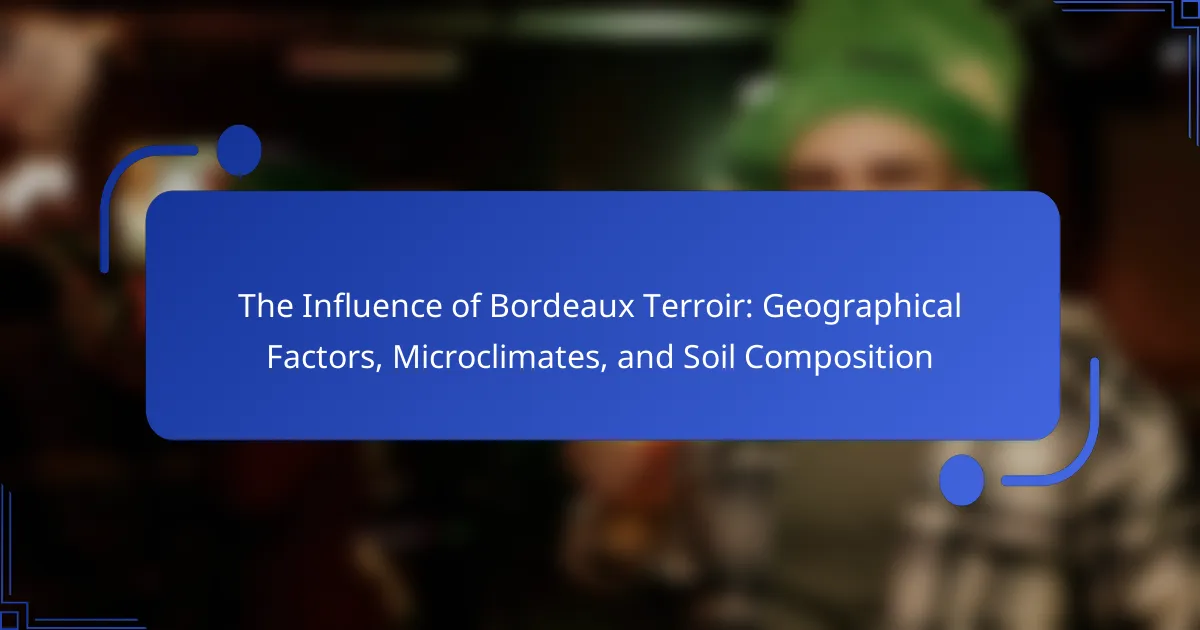
What is the Influence of Bordeaux Terroir?
Bordeaux terroir significantly influences the characteristics of its wines. Terroir encompasses the geographical location, climate, and soil composition. The region’s diverse microclimates affect grape ripening and flavor profiles. Bordeaux’s clay, limestone, and gravel soils contribute to drainage and nutrient availability. These soil types determine the grape varieties that thrive in specific areas. Historical evidence shows that wines from Bordeaux exhibit unique qualities based on their terroir. For instance, wines from the Médoc region are known for their tannic structure due to gravel soils. This combination of factors creates distinct wine styles that reflect the terroir.
How do geographical factors shape Bordeaux Terroir?
Geographical factors significantly shape Bordeaux Terroir. The region’s location near the Atlantic Ocean moderates its climate, creating ideal conditions for grape growing. The Gironde estuary influences temperature and humidity levels, promoting a diverse range of grape varieties. Bordeaux’s varied topography includes hills and valleys, which affect sunlight exposure and drainage. The soil composition, featuring gravel, clay, and limestone, contributes to the unique characteristics of the wines. These elements combined create microclimates that enhance the quality of the grapes. Historical data shows that these geographical factors have been crucial in establishing Bordeaux as a premier wine-producing region.
What role does climate play in the characteristics of Bordeaux Terroir?
Climate significantly influences the characteristics of Bordeaux Terroir. The region experiences a maritime climate, which provides moderate temperatures and consistent rainfall. This climate allows for a long growing season, essential for grape maturation. The proximity to the Atlantic Ocean moderates temperature extremes, protecting vines from frost. Additionally, the climate contributes to the diversity of microclimates within Bordeaux. These microclimates can affect grape varieties and their ripening. For instance, warmer areas may favor Merlot, while cooler zones benefit Cabernet Sauvignon. Historical data shows that Bordeaux’s climate has been stable, aiding in consistent wine production. Therefore, climate is a critical factor in defining the unique terroir of Bordeaux.
How does topography impact the wine produced in Bordeaux?
Topography significantly impacts the wine produced in Bordeaux. The region’s varied elevation affects sunlight exposure and drainage. Higher slopes receive more sunlight, enhancing grape ripening. Conversely, lower areas may retain moisture, influencing grape health. The presence of hills and valleys creates diverse microclimates. These microclimates contribute to the complexity of flavors in the wine. Additionally, the soil composition varies with topography, affecting root development. This interplay of factors results in distinct wine characteristics across Bordeaux’s vineyards.
What are the key components of Bordeaux Terroir?
The key components of Bordeaux Terroir include soil composition, climate, and topography. Soil types in Bordeaux vary, with gravel, clay, and limestone being prevalent. These soils influence drainage and heat retention, impacting grape quality. The climate is maritime, characterized by mild winters and warm summers. This climate allows for optimal grape ripening. Topography includes hills and valleys, which create microclimates. These microclimates can enhance or limit grape growth in specific areas. Together, these components create the unique terroir of Bordeaux, essential for its renowned wines.
What types of soil are found in Bordeaux and how do they affect wine quality?
Bordeaux features several soil types, including gravel, clay, limestone, and sand. Gravel soils are well-draining and retain heat, benefiting red grape varieties like Cabernet Sauvignon. Clay soils hold moisture and nutrients, supporting Merlot grapes. Limestone provides excellent drainage and mineral content, enhancing acidity in wines. Sandy soils promote early ripening of grapes due to their warmth. The combination of these soils contributes to the complexity and quality of Bordeaux wines. Studies show that terroir, including soil type, significantly influences the flavor profile and aging potential of wines from this region.
How do microclimates contribute to the diversity of Bordeaux wines?
Microclimates significantly enhance the diversity of Bordeaux wines. They create varying temperature and humidity conditions within the same region. These variations allow different grape varieties to thrive in specific areas. For instance, cooler microclimates are ideal for producing high-acidity white wines. Warmer microclimates benefit red grape varieties, leading to richer flavors. The presence of rivers and hills also influences these microclimates. They can create pockets of warmth or coolness that affect grape ripening. Consequently, Bordeaux wines exhibit a wide range of flavors and characteristics. This diversity is a key factor in the region’s reputation for high-quality wines.
Why is understanding Bordeaux Terroir important for winemakers?
Understanding Bordeaux Terroir is crucial for winemakers because it directly influences the quality and characteristics of the wine. Terroir encompasses the geographical location, climate, and soil composition of a vineyard. Each of these factors affects grape growth and flavor profiles. For instance, Bordeaux’s diverse microclimates can produce grapes with varying acidity and sugar levels. Soil types, such as gravel or clay, impact drainage and nutrient availability. Historical evidence shows that specific terroirs in Bordeaux, like the Médoc, are renowned for producing high-quality Cabernet Sauvignon. Thus, knowledge of terroir enables winemakers to select appropriate grape varieties and optimize their cultivation practices. This understanding ultimately leads to better wine quality and market success.
How does terroir influence grape varieties cultivated in Bordeaux?
Terroir significantly influences grape varieties cultivated in Bordeaux. Terroir encompasses the unique combination of geography, climate, and soil types. These factors determine which grape varieties thrive in specific regions. Bordeaux’s diverse terroirs create distinct growing conditions. For example, the Medoc region features gravelly soils that favor Cabernet Sauvignon. In contrast, the Right Bank’s clay soils are optimal for Merlot cultivation. Additionally, microclimates within Bordeaux affect ripening and flavor profiles. Historical practices have further shaped the selection of grape varieties. Overall, terroir plays a crucial role in defining the character of Bordeaux wines.
What implications does terroir have for wine aging and flavor profiles?
Terroir significantly influences wine aging and flavor profiles. It encompasses the unique combination of soil, climate, and topography in a specific region. These factors affect grape development, leading to distinct flavor characteristics. For example, Bordeaux’s clay and limestone soils retain moisture, impacting the vine’s growth and grape composition. The region’s microclimates also create variations in temperature and humidity. These variations can enhance the complexity of flavors in the wine. Studies show that wines from specific terroirs exhibit unique taste profiles that evolve differently over time. This evolution is crucial for aging potential, as certain terroirs produce wines that can mature gracefully, developing deeper flavors and aromas.

How does Bordeaux Terroir connect to wine quality?
Bordeaux Terroir significantly influences wine quality. The term “terroir” encompasses the unique combination of geography, climate, and soil characteristics in Bordeaux. These factors create specific growing conditions for grape varieties. For example, well-drained gravel soils enhance the ripening of Cabernet Sauvignon. The region’s mild maritime climate allows for a longer growing season, promoting flavor development. Additionally, microclimates within Bordeaux can lead to variations in grape maturity. Studies show that wines from distinct terroirs exhibit unique flavor profiles and complexities. This connection between terroir and wine quality is essential for understanding Bordeaux’s reputation.
What specific factors of terroir contribute to the quality of Bordeaux wines?
The specific factors of terroir that contribute to the quality of Bordeaux wines include soil composition, climate, and topography. Soil types in Bordeaux, such as gravel, clay, and limestone, influence drainage and nutrient availability. The region’s maritime climate provides a balance of warmth and moisture, essential for grape ripening. Additionally, the varied topography creates microclimates that affect grape development. Historical data shows that these terroir elements have been linked to the distinct characteristics of Bordeaux wines. For instance, the gravel soils of the Médoc region are known for producing high-quality Cabernet Sauvignon. The combination of these factors results in the unique flavor profiles and aging potential of Bordeaux wines.
How do soil composition and drainage affect grape development?
Soil composition and drainage significantly affect grape development. The type of soil influences nutrient availability and root growth. For instance, sandy soils provide excellent drainage but may lack nutrients. Clay soils retain moisture but can lead to poor drainage and root rot. Well-drained soils promote healthy root systems, essential for nutrient uptake. Drainage affects water availability during critical growth phases. Excess water can hinder grape quality by diluting flavors. Studies show that optimal soil types, like limestone and gravel, enhance grape quality in Bordeaux. These soils support better drainage and nutrient retention, crucial for premium wine production.
What is the relationship between microclimates and vintage variability?
Microclimates significantly influence vintage variability in wine production. Microclimates are localized climate conditions that differ from the surrounding area. They can affect temperature, humidity, and sunlight exposure. These variations directly impact grape ripening and flavor development. For instance, a warmer microclimate can lead to earlier harvests. Conversely, cooler areas may prolong the growing season. This variability results in differences in wine characteristics from year to year. Research indicates that specific microclimates in Bordeaux contribute to unique vintage profiles. Thus, the relationship between microclimates and vintage variability is crucial for understanding wine quality and diversity.
How can winemakers leverage Bordeaux Terroir for optimal production?
Winemakers can leverage Bordeaux Terroir by understanding its unique geographical factors, microclimates, and soil composition. The region’s diverse soils, including gravel, clay, and limestone, influence grape varieties. Winemakers can select grape varieties that thrive in specific soil types, enhancing flavor profiles. Microclimates within Bordeaux create variations in temperature and humidity. These microclimates can be utilized to optimize ripening and harvest times. Additionally, the region’s historical practices provide insights into effective vineyard management. By integrating traditional methods with modern techniques, winemakers can maximize quality and yield. The combination of these elements leads to the production of high-quality wines that reflect the distinctive terroir of Bordeaux.
What practices can enhance the benefits of terroir in winemaking?
Practices that can enhance the benefits of terroir in winemaking include site selection, soil management, and sustainable farming techniques. Site selection involves choosing vineyard locations that best reflect the unique characteristics of the terroir. Soil management focuses on maintaining soil health to support vine growth and expression of terroir. Sustainable farming techniques, such as organic or biodynamic practices, promote biodiversity and enhance the natural qualities of the vineyard. These practices allow winemakers to capture the essence of the terroir in their wines. Research shows that vineyards employing these methods often produce wines with greater complexity and authenticity, reflecting the specific attributes of their environment.
How do vineyard management techniques vary based on terroir characteristics?
Vineyard management techniques vary significantly based on terroir characteristics. Terroir encompasses soil type, climate, and topography, which influence vine growth. For instance, sandy soils drain quickly and require more frequent irrigation. In contrast, clay soils retain moisture, reducing irrigation needs.
Microclimates also dictate management practices. Cooler regions may necessitate earlier harvests to maintain acidity. Warmer areas might require canopy management to prevent sunburn on grapes.
Additionally, nutrient availability in the soil affects fertilization strategies. Nutrient-poor soils may need more organic amendments, while fertile soils can rely on minimal inputs.
These variations in vineyard management ensure optimal grape quality and yield, tailored to the specific terroir of each vineyard.

What are the challenges associated with Bordeaux Terroir?
Bordeaux Terroir faces several challenges that impact wine production. Climate change affects temperature and rainfall patterns, leading to inconsistent grape ripening. Soil erosion threatens the integrity of vineyard landscapes. Pests and diseases, such as powdery mildew, pose significant risks to vine health. Water management is crucial due to varying rainfall and drought conditions. Regulatory constraints can limit vineyard practices and innovation. Additionally, competition from other wine regions can affect market share and pricing. These challenges require careful management to maintain the quality of Bordeaux wines.
What environmental factors threaten the integrity of Bordeaux Terroir?
Climate change poses significant threats to the integrity of Bordeaux Terroir. Rising temperatures can alter grape ripening processes. Increased rainfall leads to higher disease pressure in vineyards. Drought conditions can stress vines, affecting yield and quality. Soil erosion caused by heavy rains can degrade the land. Pollution from nearby urban areas can contaminate local water sources. These factors collectively jeopardize the unique characteristics of Bordeaux wine. Studies indicate that climate variability may reduce the predictability of harvests in the region.
How does climate change impact the traditional terroir of Bordeaux?
Climate change alters the traditional terroir of Bordeaux by impacting temperature, precipitation, and grape ripening. Increased temperatures can lead to earlier harvests. This shift affects the balance of acidity and sugar in grapes. Changes in rainfall patterns can influence soil moisture levels. Drier conditions may stress vines and affect grape quality. Additionally, climate change can lead to the emergence of new pests and diseases. These factors collectively threaten the unique characteristics of Bordeaux wines. Studies indicate that the region’s traditional grape varieties may struggle to adapt to these changes.
What measures can be taken to preserve the unique characteristics of Bordeaux Terroir?
Implementing sustainable viticulture practices is essential to preserve the unique characteristics of Bordeaux Terroir. This includes reducing chemical inputs and adopting organic farming methods. Crop rotation can enhance soil health and biodiversity. Maintaining traditional grape varieties helps retain the region’s unique flavor profiles. Protecting local ecosystems ensures the balance of flora and fauna. Implementing water conservation techniques safeguards vital resources. Supporting local regulations that limit urban development protects vineyard lands. Engaging in community education fosters awareness of terroir preservation. These measures collectively contribute to maintaining the integrity of Bordeaux’s distinctive terroir.
What strategies can winemakers adopt to adapt to terroir challenges?
Winemakers can adopt several strategies to adapt to terroir challenges. These strategies include selecting grape varieties suited to specific soil types. For instance, certain grape varieties thrive in clay soils, while others prefer sandy soils. Implementing precision viticulture techniques can enhance vineyard management. This includes using technology to monitor soil moisture and nutrient levels. Adjusting vineyard practices, such as canopy management, can optimize sunlight exposure and airflow. Additionally, utilizing cover crops can improve soil health and biodiversity. Employing sustainable practices helps mitigate the impact of climate variability. Finally, collaborating with local research institutions can provide valuable insights on adapting to changing conditions.
How can innovation in viticulture address the challenges posed by terroir?
Innovation in viticulture can address the challenges posed by terroir through advanced agricultural techniques. These techniques include precision viticulture, which utilizes data analytics and technology to monitor vineyard conditions. By analyzing soil composition and microclimates, winemakers can optimize grape varieties suited to specific terroirs.
Additionally, innovations such as drought-resistant rootstocks can enhance resilience against climate variability. For instance, research indicates that using specific rootstocks can improve water efficiency in regions facing drought.
Furthermore, the use of drones and satellite imagery allows for real-time monitoring of vineyard health and soil conditions. This data-driven approach enables targeted interventions, improving grape quality despite challenging terroir conditions.
Overall, these innovations lead to sustainable practices that enhance wine production while respecting the unique characteristics of the terroir.
What practical tips can be applied to understand and utilize Bordeaux Terroir?
To understand and utilize Bordeaux Terroir, one should study the region’s soil types. Bordeaux features diverse soils, including clay, limestone, and gravel. Each soil type influences grape varietals differently. Analyze microclimates within Bordeaux, as they affect ripening and flavor profiles. Observe the impact of elevation and proximity to water bodies on temperature regulation. Engage with local winemakers to gain insights on terroir’s practical applications. Tasting wines from various appellations reveals the nuances of terroir. Lastly, consider the historical context of Bordeaux winemaking, which shapes current practices and varietal selections.
How can wine enthusiasts appreciate the influence of terroir in their tasting experiences?
Wine enthusiasts can appreciate the influence of terroir by understanding its components. Terroir encompasses the unique environmental factors affecting grape cultivation. These include soil composition, climate, and topography. Each factor contributes distinct flavors and aromas to the wine. For instance, Bordeaux wines exhibit characteristics influenced by their specific soil types, such as gravel or clay. Additionally, microclimates in Bordeaux create variations in grape ripening. Enthusiasts can enhance their tasting experiences by comparing wines from different terroirs. This comparison highlights how geography shapes wine profiles. Tasting alongside knowledgeable guides can also deepen appreciation. Engaging in vineyard tours further reveals the intricacies of terroir.
What resources are available for learning more about Bordeaux Terroir?
Books on Bordeaux Terroir include “Bordeaux: The Definitive Guide” by Steven Spurrier. This book provides insights into the region’s geography and soil types. Academic journals like the “Journal of Wine Research” publish studies on terroir’s impact on wine quality. Websites such as the Bordeaux Wine Council’s official site offer detailed information on terroir characteristics. Online courses from institutions like the Wine & Spirit Education Trust cover Bordeaux’s unique terroir. Additionally, local vineyards often provide educational tours and tastings focused on terroir. These resources collectively enhance understanding of Bordeaux Terroir’s influence on wine production.
The main entity of the article is Bordeaux Terroir, which encompasses the geographical factors, climate, soil composition, and topography that influence wine characteristics in the Bordeaux region. The article examines how these elements create distinct microclimates and affect grape varieties, ripening, and flavor profiles. It highlights the significance of soil types, such as gravel, clay, and limestone, in determining wine quality and aging potential. Additionally, the article addresses the challenges posed by climate change and offers strategies for winemakers to adapt and leverage Bordeaux Terroir for optimal wine production.
